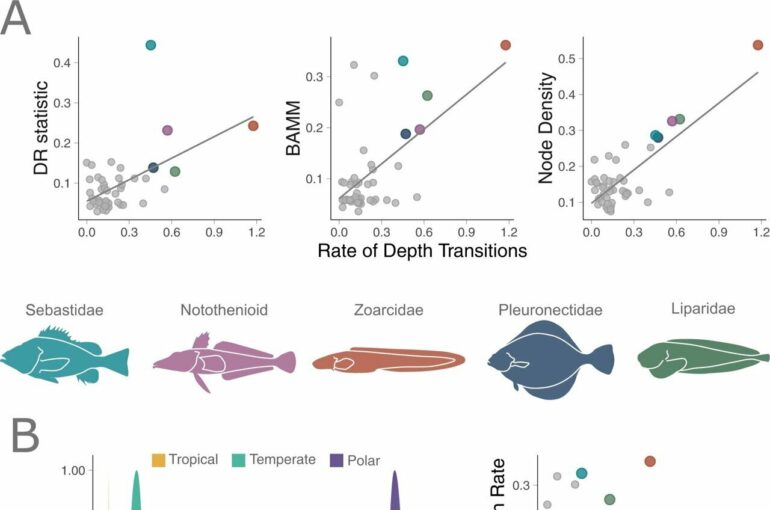Fish, the most biodiverse vertebrates in the animal kingdom, present evolutionary biologists a conundrum: The greatest species richness is found in the world’s tropical waters, yet the fish groups that generate new species most rapidly inhabit colder climates at higher latitudes.
A new study helps to explain this paradox. The researchers discovered that the ability of fish in temperate and polar ecosystems to transition back and forth from shallow to deep water triggers species diversification.
Their findings, published Feb. 11 in the journal Nature Communications, suggest that as climate change warms the oceans at higher latitudes, it will impede the evolution of fish species.
“The fish clades contributing the most fish diversity in today’s oceans are leveraging the water column and the ocean depths, in particular, to diversify,” said lead author Sarah T. Friedman, who conducted the research while a G. Evelyn Hutchinson postdoctoral associate at Yale.
“Fishes that make these forays into the deep ocean are almost exclusively located in high latitudes, where it’s easier to move along the water column. These regions are experiencing the most drastic warming due to climate change, which threatens to disrupt speciation by making it more difficult for fish to change depths.”
Friedman, now a research fish biologist at the National Oceanic and Atmospheric Administration, coauthored the study with Martha Muñoz, an assistant professor of ecology and evolutionary biology in Yale’s Faculty of Arts and Sciences, and an assistant curator of vertebrate zoology at the Yale Peabody Museum.
For the study, the researchers analyzed existing data on the global species occurrence of 4,067 fish species that included information on species geographic range and speciation rate. In part, their analysis modeled how often fish lineages might be expected to transition across ocean depths. By laying out a distribution of anticipated shifts in depth, the researchers could compare the number of observed transitions in specific lineages.
They found that species-rich, high-latitude lineages—eelpouts, rockfishes, flatfishes, icefishes, and snailfishes—transitioned up and down the water column more often than expected. Meanwhile, hyper-diverse tropical lineages, such as gobies and wrasses, changed depth less frequently than predicted.
Fish clades, evolutionary lineages that share a common ancestor, that can freely disperse along the depth gradient may be more likely to capitalize on novel resources or niches at specific depths and become isolated from other members of their group, the researchers said. This can lead to repeated local adaptation and the evolution of new species.
Many variables can affect a fish’s ability to move between depths, including water temperature, pressure, and light penetration. Friedman and Muñoz suggest that temperature plays an important role in the ability of high-latitude fish clades to transition along the water column. Fish clades that inhabit colder water have an easier time traveling into ocean depths, where water temperature plummets dramatically. By contrast, tropical fish, which spend their lives in warm, shallow waters, face steep thermal barrier to transitioning to the deep ocean, the researchers said.
The existing high biodiversity in tropical waters could be a remnant of the deep past when warmer regions were hotbeds of species generation, but over time, most diversification began occurring closer to the Earth’s poles, they explained.
But this biodiversity engine at higher latitudes is vulnerable to climate change. Since the water profile is so much more uniform at higher latitudes than in the tropics, the fish that inhabit them are physiologically fine-tuned to those environments, Muñoz explained. For them, a one-degree shift in temperature will be physiologically more challenging than for an organism that is more of a thermal generalist.
“As the oceans warm, organisms might face steeper barriers to dispersal across the depth column,” Muñoz said. “Over time, I think we’ll see a slowdown of this engine of biodiversification.”
More information:
Sarah T. Friedman et al, A latitudinal gradient of deep-sea invasions for marine fishes, Nature Communications (2023). DOI: 10.1038/s41467-023-36501-4. www.nature.com/articles/s41467-023-36501-4
Citation:
Study reveals biodiversity engine for fishes: Shifting water depth (2023, February 13)



